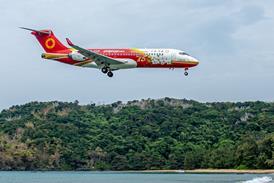As fitter and trimmer Delta Air Lines and Northwest Airlines get ready to say goodbye to the US Chapter 11 process what kind of shape will the former bankrupts emerge in? Are they future-proofed to avoid this court of last resort?
In show business they talk about a tough act to follow, and that is deeply true of the way in which major US airlines have made the bankruptcy courts the centre stage of their most recent act of transformation. Two of the largest carriers, Delta Air Lines and Northwest Airlines, are about to leave this chapter. They return to business as usual, minus billions in debt and other obligations shed courtesy of spectacular unilateral powers gained when they went into bankruptcy power within a half-hour of each other in September 2005.
By February of 2007, Delta proudly noted, it had taken some $3 billion in costs out of its operation while improving its performance. This renaissance helped it post an operating profit of $58 million for 2006, although stunningly huge reorganisation and other one-time charges forced a $6.2 billion net loss.
Asked if the carrier could have done what it did without the powers of bankruptcy, Northwest chief executive Doug Steenland responded firmly: "No." Steenland went on to detail the several years of efforts he and his team had made to persuade Northwest unions to grant deep enough concessions on pay and work rules to help the carrier compete in the scary new world of low-fare competition. Progress toward this, Steenland says, had been slow, "and then came the fuel cost spike". The airline then had no choice but to seek protection from its creditors, he says.
Without the power bankruptcy grants a carrier to compel owners of its aircraft to renegotiate lease rates down, adds Steenland, the carrier could not have slashed its costs by $2.4 billion and its debt by $4.2 billion. Steenland says the intent was "to restructure the airline once and do it in a way to allow the airline to be viable for a long, long time". Unit costs for Northwest and Delta counting labour, but not fuel, fall just between those of US Airways and Continental, with United and American somewhat higher. But Southwest, JetBlue and AirTran still boast costs that are an order of magnitude lower.
Northwest actually made money in 2006, both on the operating and net level, with its bottom line $301 million in the black. It also plans, says Steenland, to distribute $1.5 billion in profit-sharing and stock to its front-line employees. At least to the ones that are still there. Both carriers forced out thousands of workers while persuading employees to "voluntarily" agree to pay cuts. Many more just left, driven away by the prospect of further culls.
Both carriers have begun to recall some of their furloughed workers, with Delta actually finding itself wanting more pilots than were on its furlough list. But these recalls were not the result of the bankruptcy process any more than were the rising unit revenues that both have enjoyed. Along with the rest of the industry and along with such fellow former bankrupts as United Airlines, it is the rising tide of the industry's fortunes that has made this improvement possible. Of course, in the first place fortune also played its part in pushing Delta and Northwest to the precipice from which hurricanes and the fuel shock toppled them.
Some might suggest that the true enjoyment of these happy days should be at American Airlines. There, executives resisted the siren call of the bankruptcy courts, just as they had resisted it in the 1980s and 1990s when Continental went through bankruptcy and Eastern and Pan Am never came out.
American is now the only major airline never to have sought the shelter of bankruptcy, even though it suffered the same fuel price shock and went through the same often-bitter employee concessions bargaining. American has been loath to complain too much about this seeming inequality that has produced a rough equity of outcomes. But others, especially on the other side of the Atlantic, have made the point.
It is proper, and easy, to debate the fairness issue. But the tough question is what comes next. Are the US majors now truly in shape to weather the next extraordinary shock, whatever its origin? Or is another round of bankruptcy court visits almost inevitable the next time forces of nature combine with economic forces to rewrite a basic part of the operating cost formula?
Only the most optimistic could confidently predict that the courts will not be in business again in the next downturn. This is an industry so struggling with its various legacies it has rarely shown itself to be future-proofed.
Nominations pleaseThe nominations are now open for this year's Airline Strategy Awards. To put forward your chief executive or airline visit: strategyawards.com The Airline Business blogs, written by the magazine's editors and taking a sideways look at the industry, have had a make over, visit www.flightglobal.com/ABblogs |
|---|
Source: Airline Business























